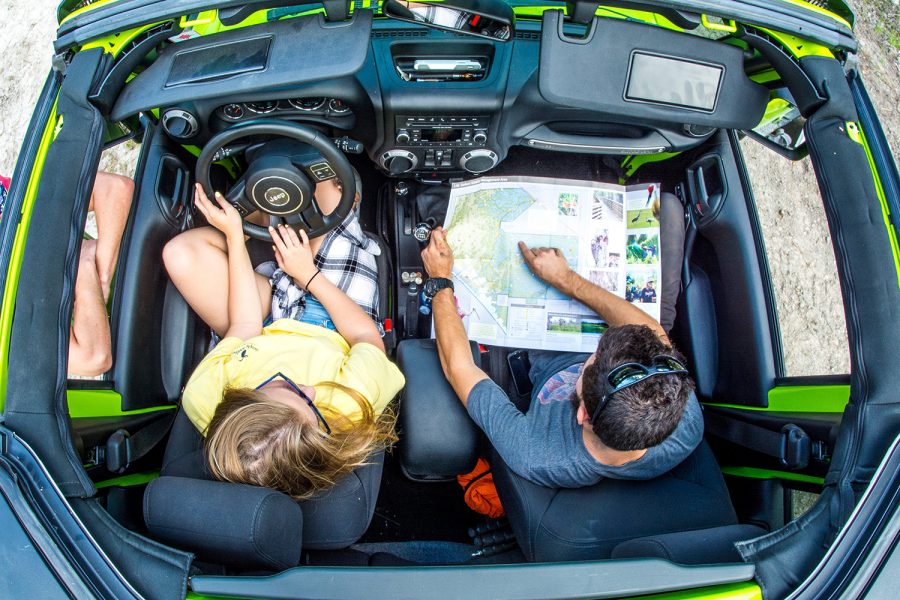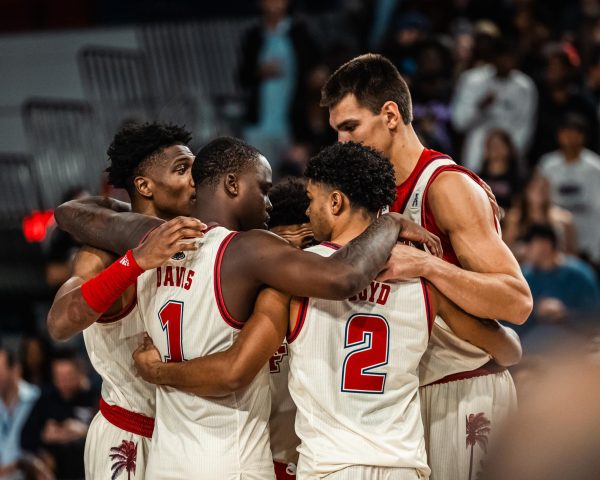Globetrotting with empty pockets
How to go far from home on a college budget.
February 28, 2017
Traveling warrants a lot of questions: Where are you going? Where did you come from? How’d you get there? But the biggest question is always, “How did you afford it?” My answer: the slower you travel, the cheaper.
Hitchhike for free and get through maybe two cities in a day. Dish out big bucks for a flight and cross the globe. Couchsurf for free and maybe get a bed but definitely make friends. Stay in a hostel and definitely have a bed and maybe make friends. It all depends on your time frame. Two days? Two weeks? Two months?
If you’re looking to travel over spring break, time isn’t really on your side. However, if you’re planning for summer, you have more options. Here’s what I’ve learned to make the most of the money you have for the time you have.
SLEEPING:
Couchsurfing:
The next most expensive thing is a place to sleep. As most people don’t want to sleep in a bush in the park wherever they go (I had to do this in Budapest), Couchsurfing.com (see sidebar) would be the next cheapest thing as it’s also free. But, you have to be willing to go a bit farther and try a little harder than buying a hotel room.
- You may see it as staying with strangers and that you have to be careful, but they’re letting a stranger stay at their place too. I’ve stayed with four 20-year-old college kids in Ljubljana, Slovenia, a 50-year-old rich doctor in Paris, France, the parents of a 27-year-old hitchhiker in Saint-Avold, France — people of all kinds and cultures. Don’t be afraid of strangers so much, there are nice people everywhere.
- References are Couchsurfing’s version of Yelp reviews. People write about the host after staying with them, whether their house was clean, what they did with them, how interesting or fun they were, whatever it may be. It works the other way as well. Your host will write a reference for you saying how much you followed house rules, how fun and considerate you were, and other hosts read those to determine if they’ll host you or not.
- There are thousands of couchsurfers everywhere and they are usually locals. It’s more often than not the best to stay with them as they’ll be from the area and know things you wouldn’t think to find, like a mountain hike in the middle of Puerto Rico off the highway, or a hidden squat down the street or the secret catacombs of Paris.
Couchsurfing and Your Profile:
Couchsurfing.com is a website that aims to put you, as a traveler, in touch with someone who is willing to let you crash on their couch in exchange for your cooking skills, awesome stories, killer guitar-playing skills or whatever nice thing you can do for the person. The point is travelers helping travelers however they can. During the summer, I used Couchsurfing over 30 times to find a place to sleep in Europe when I didn’t have money to pay for a hostel.
You have to look personable and safe to get a place. Make sure your profile is filled out completely with clear pictures of yourself and has as much detail as you have the patience to include. You find hosts searching by city and they read your profile to decide whether they’d enjoy having you. When you send a message to a host, explain what you’re doing, why you want to stay with them and try to ask them about a week before you need to stay.
Hostels:
Hostels are basically college dormitories run like hotels. If you’re able to spend a little money, you’ll be in a bunk bed with maybe 10 other people to a room. They are very cheap compared to hotels and it’s easy to meet other travelers as those are usually the only people staying there, but you won’t meet many locals.
- There are different kinds of hostels. In major cities, you will find the ones with fancy decorations, TVs, beer pong and bars — essentially the party ones. Next you’ll find the ones that get business simply because the party ones only have so many rooms, and they’re usually more expensive. These secondary hostels have bars as well but are a lot more calm and simple and roughly $10 a night. If there’s one amazing thing about hostels internationally, the cheaper ones are almost always around $10, if you can get the cheapest room.
- Hostels also have bathrooms and showers, with towels and sheets for you to use. Many have kitchens and fridges that can be used as well without any extra charge, and cooking with groceries is cheaper than going out to eat.
- The people who work at hostels and the people who stay at them have a unique knowledge. They are almost always travelers with a lot of experience and if they work there, they know a ton about the area. Ask them about places to go that aren’t common so you can see the local scene. You’ll find out about squats, underground concerts, all kinds of places and ideas that you wouldn’t have found on your own.
TRAVELING
Flying:
Flying usually ends up being the most expensive way to travel, but the cheapest — and sometimes necessary — way to travel fast. The difference depends on luggage (see sidebar for packing essentials), how many flights the trip takes and where you’re flying to and from with whatever transport in between.
- I never travel with more than a carry-on. This way I can avoid any checked bag fees that are normally around $25 and up. It also ensures that I’m not packing too much (remember: the more you pack, the more you have to carry), and with multiple connecting flights, your checked bag could very well end up on the other side of the country or not arrive until days after you.
- Because major international airports tend to be less pricey than others, it can be cheaper to, say, take a plane from Orlando to New York and then take a Greyhound bus to Rhode Island, instead of a direct flight to Providence. Check prices of nearby airports and your destination, as well as bus or train prices. It can end up cheaper and you could see more on the way.
- Always check for cheaper flights in surrounding cities. Waking up an hour earlier to get to another airport and save $50 is well worth it. I once took a bus four hours out of the way for a cheaper flight and saved $70. In Florida, Orlando is usually the cheapest followed by Fort Lauderdale and then Miami.
- Keep an open mind to times and days. Sunday could be $40 cheaper than Tuesday at 5 p.m. and 7 a.m. could be $50 cheaper than 5 p.m. Saturdays are the cheapest days to fly in my experience, with Google Flights being what I use to compare places and times. Use it, love it, spend hours checking every possible combination of days, times, places and airports each day of the week. Prices change daily.
- At almost every airport, there is a free shuttle that goes to bus stations and back or to other common places to pick people up. Look for it, ask around — it’s another $20 you can save.
When in Rome:
I went to Rome from Rhode Island and back for $650 last summer. This is almost half of what it normally costs to fly that far across the ocean during tourist season. The catch was it took me about 30 hours to get there.
I took a four hour, $30 bus ride from Rhode Island to New York City because flying out of JFK International Airport was cheaper than Providence, Boston or anywhere else around. After my eight hour, overnight flight, I took a connecting flight through Moscow with a six-hour delay because it was also cheaper instead of direct. I did all of this with a small Nike duffel bag as a carry-on for my two-week stay with a friend to save on checking bags.
Hitchhiking:
The cheapest and slowest way to travel is my favorite: hitchhiking. I hitchhiked over 2,500 miles in two months in Europe during the summer and met a tremendous amount of people doing the same thing, finding places to sleep with kind people because of it as well. You meet locals, see little towns and open up your adventure to other people and places, and get a little mystery added.
- You need patience. The point of hitchhiking is enjoying the journey, so focus on your surroundings and look around, you won’t get a ride right away. You also probably won’t get straight to the city you are going, you’ll get picked up and dropped off multiple times. Again, the next best thing is to enjoy right where you are while you wait.
- You need a sign saying where you are going, be it cardboard or a notebook. I used a notebook as it had lots of paper and I could change my sign if it wasn’t working. Use big bold letters and note that the bigger the sign, the quicker they see it and the more time they have to decide to stop for you.
- Look fun. I would sing to myself and kind of dance in place a bit. No one wants to pick up someone on the side of the road that looks bored and grumpy. Wave at people as they pass, make sure they can see your sign, smile and keep your thumb out.
- People pick up “thumbers” because they want entertainment, they’ve hitchhiked before and know it’s rough or because they know someone who’s been there. Try to be fun and talkative about what you’re doing and why, ask them if they’ve ever hitched before, ask them why they picked you up. Be social and you’ll both enjoy the ride.
- You could do all of this and still not find a ride because no one is going the direction you need. Get to the edge of the city where the traffic goes in the direction you are traveling, be somewhere a car can safely pull over out of the way of traffic (something like a stoplight or stop sign where you could hop in) and try to find a highway on-ramp. They can be very good places as you know that the cars driving by are leaving the city. Keep in mind, do not go onto the highway by foot; hitchhiking on highways is always illegal and very dangerous.
What to Pack:
Packing is always an issue. How many pairs of socks? How many bras? Shirts? Pants? Sandals or sneakers? How much money? Toothbrush, deodorant , toothpaste?
In general, stick to clothes — roll them instead of folding to save space — a med kit, a compass, a camera and maybe a Sharpie and a journal. Anything else, like a toothbrush, you can buy wherever you’re going to save space and weight, there’s always a baggage weight limit and it’s easy to accidentally go over with a lot of small nonessential items.
If you’ll be in warm weather, you don’t need more than three T-shirts, a pair of jeans, a pair of shorts, five pairs of socks and underwear. Also, take boots as you never know when it’ll rain. A good sized backpack for flying and traveling with is about 50 liters. It’s a useful size for backpacking and hiking and fits on airlines as a carry-on.
Andrew Fraieli is a contributing writer for the University Press. For information regarding this or other stories, email him at [email protected].














